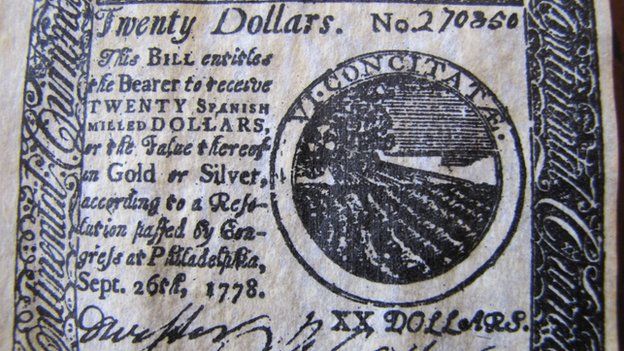The pre-history of the US dollar
- Published

Later this month, the Federal Reserve marks its centenary. One of its most important tasks is managing the dollar, the official US currency for more than 200 years. But what did settlers in the New World use instead of money before either the Fed or the dollar came into existence?
In 1620, the Mayflower set sail from Rotherhithe in East London bound for the New World, carrying religious dissenters in search of a new life overseas. Those first settlers took with them gold and English coins. But they weren't wealthy and they soon ran out of hard money, leaving them without means of buying food, animal skins and other necessities from the indigenous people of the American continent.
Jason Goodwin, author of Greenback: the Almighty Dollar and the Invention of America sums up the difficulty: "They simply didn't have any cash. They weren't very loaded when they came over in the first place. And it became quite awkward for the colonists to do exchanges between themselves… it was all very well to barter one thing for another, but of course quite soon you get into quite complex exchanges, and that's where money is so incredibly useful."
Soon after their arrival, the settlers discovered that certain kinds of shell - known as wampum - had great symbolic significance for many native Americans and as such could be exchanged by the English colonists for the things they needed, such as food. In fact, the wampum became so important in the early days of trading in what is now the Eastern seaboard of the US that in 1637 the Massachusetts Bay Colony declared them to be legal tender.
As trade among the settlers themselves became increasingly important, they started to use other goods for bartering. In the northern colonies they used corn and cod, for example, and in the more southerly colonies they also favoured tobacco. Many of these goods were declared legal tender at one time or another, although not all proved successful.
Jason Goodwin says that the value of tobacco tended to fluctuate depending on the success or otherwise of the crop. But there was, he says, another problem with tobacco: "The leaves were put in store and then circulated, but of course they became very crumbly and dry and people always tried to pay people off with all the crumbliest and driest of their tobacco leaves. And it caused a lot of confusion, because if your currency is actually deteriorating as well as losing value as you use it, it is not much good."
Goodwin also points out that when the settlers tried using nails some were tempted to burn down wooden barns in order to extract the nails, which had a value similar to money.
The price of goods tended to be different if you were paying in hard money - gold or silver or coins of one kind or another - rather than one of the forms of legal tender such as wampum. This was because hard money was more widely accepted and therefore more useful. As Madame Knight, a Boston schoolmistress observed in 1704 -with something of an understatement - it was a "very intricate way of trade".
Those early colonists, though, had few options other than this relatively sophisticated form of bartering because the British authorities refused to permit the export of gold and silver coins - and also refused to allow the colonists to mint their own coins. It was easier to get hold of Spanish coins such as the real, and these were still circulating in the US in the early 19th Century.
Eventually, the intransigent attitude of the British authorities, coupled with the burden of taxes levied on the settlers by the British government, led to a complete break with Britain. The colonists issued their famous Declaration of Independence in 1776 and after the prolonged and bitter War of Independence succeeded in defeating the British forces in 1783.
The Revolutionary War, as it is also known, left the 13 states of the Union in financial chaos.
The war was longer than anticipated and very expensive for the colonists. So, as Benjamin Franklin, one of the founding fathers of the Revolution explained: "Congress... issued an immense quantity of paper bills to pay, clothe, arm and feed their troops, and fit out our ships; and with this paper, without taxes for the first three years, they fought and buffeted one of the most powerful nations of Europe."
These paper bills - IOUs really - were known as Continentals, named after the Continental Congress which had been responsible for the Declaration of Independence and which managed the war against Britain. But by the end of the war, these Continentals were worthless - hence the saying "not worth a Continental" - and the new republic needed to establish economic and financial order as a matter of urgency.
In 1785, the Continental Congress met in New York and on 6 July the dollar was established as the official currency of the new United States of America.
The Congress decided it would be a decimal system with 100 cents to a dollar. But disagreements among the members of Congress - which even then was divided about the extent to which the federal government should dictate to the individual states - meant that it wasn't until 1792 that a mint was established in America.
And it was another 70 years - 1862, in the middle of the Civil War - before the US Treasury was able to print dollar bills - black on the front, green on the back, so coloured because of the chemicals used to prevent counterfeiting. And so the dollar (or greenback) as we know it today came into being.
Listen to the first of five episodes of Greenback: How the dollar came to rule the world at 13:45 GMT, on Monday 2 December.
Follow @BBCNewsMagazine on Twitter and on Facebook